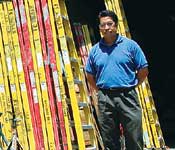 |
| CRIB CONNECTION Handheld devices scan and upload tool data. (Photo courtesy of QuickPen Intl.) |
It is no wonder that firms operating many large, expensive machines on a daily basis sometimes tend to overlook small items such as reciprocating saws and battery-powered drills, which can slip through the cracks of a jobsite at the end of a shift or when a project is completed.
But in today's economy, equipment managers are recognizing the value of trying harder to hold onto tools previously treated as more disposable assets. Now more than ever, CFOs are pressuring managers to control spending and tools are a prime target. "Right now is the best time to be an equipment guy," says Mike Monnot, director of equipment for San Antonio-based general contractor Zachry Construction Corp. Monnot manages a $180-million fleet of 4,700 pieces of heavy equipment and 1,100 service vehicles.
Monnot also operates Zachry's "corporate tool center," a storehouse of $35 million in tools. The firm last year lost $2 million in tools, a startling number that grabbed Monnot's attention. "What happens at the project level is that we will issue tools out to a foreman and won't inventory them until completion," he says. "There is no control mechanism."
 |
| LOGGED-IN Bar-code labels are a popular method for tracking small assets within firms. (Photo by Tudor Hampton for ENR) |
Ten years ago, managers started turning to bar-codes, scanners and database-driven software as a first step toward modern tool management. These systemswhich are still effective theft deterrents (ENR 3/13/00 p. 40)are evolving and changing the way traditional equipment managers perceive their role on the job. Replacing tools is one thing, but labeling, tracking, cataloging, filing and coordinating a myriad of tools is more complicated.
Last October, Monnot started phasing in bar coding on a project-by-project basis, which will continue through this year. He hopes the move will reduce loss, theft and insurance claims. But more importantly, he believes the real-time data will help him analyze cost of ownership, calculate internal rental rates and assign cost centers with more accuracy than before. The ability to "focus on every detail and try to minimize costs and maximize return" has elevated the equipment manager's perceived value from shade-tree mechanic to equipment-logistics specialist, Monnot says.
|
"It is a lot sexier to manage your tools and equipment now than it was, say, even a year ago" because of tighter operating budgets, says Don Kafka, president of ToolWatch, Englewood, Colo., an asset-management supplier since 1991. Kafka, a former electrical contractor, estimates that his bar-code and software package, which costs roughly $15,000 to implement, can save firms 40� per hour per employee compared with the 80� per employee-hour typically lost by replacing small tools. Kafka says most bar-code systems pay for themselves in three months.
 |
| UPWARD CLIMB Modern tool tracking enhanced work for Rojas. (Photo by Tudor Hampton for ENR) |
In suburban Chicago, Jorge Rojas, purchasing manager for F.E. Moran Inc., a mechanical contractor based in Northbrook, Ill., remembers tracking assets from a weathered clipboard hanging on his company's warehouse wall. He says his company owns about $1.5 million in small tools and portable equipment used to install fire-protection, security and HVAC systems. "It was a nightmare," he says. After every job wrapped up, the company was losing at least 50% in small assets, or about $300,000 annually.
Now, Rojas manages tools with his computer. In 1989, he began bar-coding and databasing every tool worth $20 or more. "When we put tools together for a job, we gather them up and scan them with a portable scanner," says Rojas. "After we send them out, I download the scanner into my computer system. When I need to get a tool, I find it in the system, so I don't need to buy another one."
For Rojas, tool recovery from job to job has reached an all-time high at 80 to 85%, saving his company roughly $200,000 in lost or stolen assets annually. His 14-year-old tool-tracking system with yearly upgrades has cost about $8,000 to date.
Tracking also creates a psychological advantage, as workers tend to change their behavior when they know they are being monitored. "It's like checking books in and out of a library," says Fred Cummins, president of WaterWheel Software, Los Altos, Calif.
 |
| COVERT Forensic science or tool management? New "DNA" paint appears under UV ray. (Photo courtesy of ToolWatch Corp.) |
Bar-code labeling differs slightly from supplier to supplier and its capabilities are improving. For example, Calgary, Alberta-based I.D.Ology Labs is partnering with firms to market "forensic chemical marking." It involves a a liquid solution containing a synthetic, molecular "DNA" that users paint on tools. Specified opaque or invisible, details of the code can be seen under ultraviolet light or a handheld spectroanalyzer.
Other suppliers are researching radio-frequency identification in which a tool houses a tiny chip transmitting data to a handheld receiver. "We're all moving in that direction," says Daryl Maggard, spokesman for QuickPen International, Englewood, Colo.
But all of this technology is not for everyone, says Bob Andrade, vice president of equipment management for The Walsh Group, Chicago. Andrade notes that his company, a large general contractor, looks at tool management site by site, reserving high-tech investment dollars for the larger assets. "The bigger jobs will have a tool crib and bar-codes. The little jobs will have a guy with a list," says Andrade, who adds that "we do mark and identify everything, though."

Post a comment to this article
Report Abusive Comment